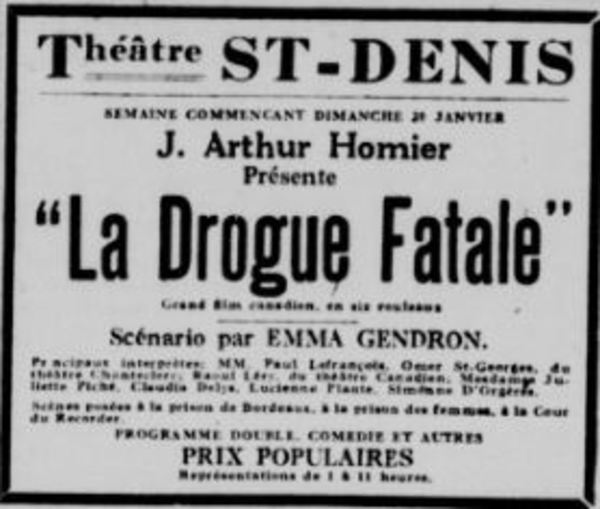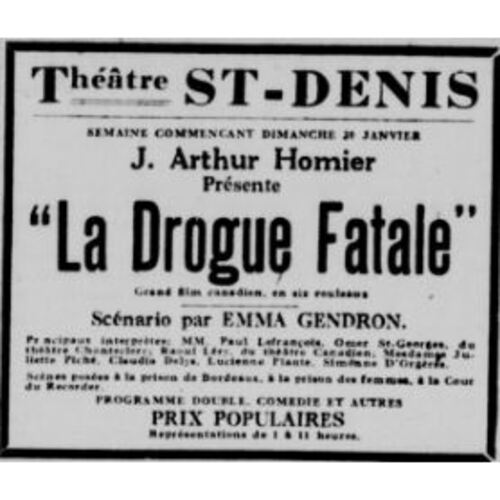
Source: Link
HOMIER, Joseph-Arthur (baptized Joseph-Louis-Arthur, he occasionally signed Arthur and more often J.‑Arthur), prestidigitator, photographer, author, and film-maker; b. 8 Aug. 1875 in Montreal, son of Joseph Homier and Henriette Gauthier; m. 22 Feb. 1898 Ernestine-Alice Bougler in Boston, and they had two sons and two daughters; d. 7 July 1934 in Montreal.
The son of a successful furrier and hatter, Joseph-Arthur Homier entered his father’s business upon completion of his studies at the Catholic Commercial Academy of Montreal [see Urgel-Eugène Archambeault*]. He soon left, however, to work as an apprentice to France’s famous prestidigitator Alexander Herrmann, known as Herrmann the Great. Homier toured Canada and the United States until his mentor’s death in December 1896. He eventually abandoned conjuring and opened a photographic studio in Montreal about 1904. Within two years he had made a name for himself with his studio-lighting techniques, and he demonstrated them across the country. Around 1915 he opened another studio, called Homier et Lavergne, and took personal and family photographs as well as official portraits of individuals such as Émile Chartier*, the first vice-rector of the Université de Montréal.
Homier also had literary aspirations that drew him to the stage and the cinema. His plays included “Le retour,” “Le lys brisé,” “Le portrait,” “Reste et tais-toi,” “Deux âmes,” and “Son fils.” At least one, Le beau soir (Montreal, 1924), was published. By 1921 Homier had become interested in the cinema, and that summer he shot his first film, a silent comedy about 40 minutes long entitled Oh! Oh! Jean, which he made in collaboration with a theatre troupe from France. Maurice Castel, its head, and Berthe Renout, the female star, played the leading roles. The cast also included local actress Juliette Béliveau*, who played a servant. Oh! Oh! Jean premiered in June 1922 at Montreal’s Théâtre Saint-Denis, the second largest in the city at the time, with 3,000 seats, and was screened for four days as part of a program that included a production of Homier’s play “Deux âmes.”
That same year Montreal businessman Samuel-Théodore Grenier, along with Homier and three other partners, founded Le Bon Cinéma Canadien Limitée with the goal of making feature films that reflected Roman Catholic and Canadian values. The firm would be renamed Le Cinéma Canadien Limitée on 22 March 1923, and a few months later the English name – The Canadian Cinema Limited – was added. For its first film the board of directors chose a historical subject, the tale of Marie-Madeleine Jarret* de Verchères, and Homier was named the director. Emma Gendron*, who would become one of Homier’s closest collaborators, wrote the script based on the biography published in 1913 by Frédéric-Alexandre Baillairgé, the parish priest in Verchères. Though only 18 years old at the time, Gendron had already written numerous short stories as well as a prize-winning play and was pursuing a career in journalism.
Filming of Madeleine de Verchères began in the fall of 1922 at the First Nations reserve at Caughnawaga (Kahnawake), where the company built a replica of the small wooden fort that the young woman had defended in 1692. The cameraman was Joseph-Armand Homier, the director’s son, and the cast included both professional and non-professional actors along with indigenous people from the reserve. The title role was played by Estelle Bélanger, a young Montreal resident. The feature-length silent film premiered on 10 Dec. 1922 at the Théâtre Saint-Denis and was subsequently shown at other theatres in the Montreal area and in Quebec City.
Critics from the French-language press responded to the film with guarded enthusiasm. It was applauded for its authenticity, a fictitious romantic subplot notwithstanding, and described as an excellent tool for familiarizing children with their province’s history. The naturalness of Bélanger’s acting earned her some praise, and reviewers predicted that she would have a successful future in film. They highlighted the fact that people from Quebec, despite their limited means, had demonstrated that film-making was not necessarily a matter to be left to foreigners ‒ it could be done in the province with a home-grown cast and crew. Madeleine de Verchères was also reviewed in the English-language press and received a particularly favourable critique from Samuel Morgan-Powell in the Montreal Daily Star.
Encouraged by the success of their first full-length feature, Homier and Gendron embarked on a second film project with a more topical subject matter: drugs. Gendron’s script for the moralistic drama, La drogue fatale (known in English as The fatal drug), tells the story of drug traffickers who blackmail a chief of police. Homier directed, and his son again served as cameraman. Shooting took place in Montreal at the Bordeaux Prison and the Catholic women’s prison, in the Recorder’s Court, and on the city’s streets. Homier also set up a studio where 23 sets were built. The cast consisted of professionals from the Montreal theatre community and numerous non-professional actors. Leading roles were played by Paul Lefrançois and Omer Saint-Georges (both from the Chanteclerc Theatre), Raoul Léry (from the Théâtre Canadien-Français and often referred to as the French counterpart of the American comedian Harold Lloyd), Juliette Piché, Lucienne Plante, Claudia Delys, and seven-year-old Alberte Lecompte (from the Conservatoire Lassalle). The premiere took place at the Théâtre Saint-Denis on 20 Jan. 1924.
Reviewers described The fatal drug as a considerable improvement over Madeleine de Verchères, and it was screened again in June 1924 for three days at the Cinéma Passe-Temps. The week of the Saint-Jean-Baptiste holiday was a veritable Homier festival: his play “Son fils” was performed at the Théâtre National Français with Raoul Léry, Rose Rey-Duzil, and Eva Prégent in the leading roles, while The fatal drug was shown at the Théâtre Canadien-Français.
In March 1924 Homier had visited New York in an attempt to attract investors for the establishment of a modern film studio in Montreal, but nothing came of this endeavour. By September he was no longer on the board of directors of Le Cinéma Canadien Limitée – The Canadian Cinema Limited, and he had sold his interest in Homier et Lavergne.
Homier’s partnership with Emma Gendron went beyond the cinema – they also collaborated on several Montreal-based literary and women’s magazines. After first contributing to Le bon loisir in 1924, Homier was director-manager for La revue de Manon from May 1926 until at least January 1928. In it he published a series of articles in 1925 and 1926 about his recollections of historical events in Montreal, under the titles “Montréal il y a quarante ans” and “Montréal depuis quarante ans.” In 1929 Homier opened a printing business in Montreal with Marjorique Gendron, Emma’s father, which they named Gendron et Homier and where they would print their publications. That same year Homier became co-owner and co-editor of La revue du foyer, and in 1931 co-owner of the literary magazine Le dimanche illustré, the other partner being Emma.
Joseph-Arthur Homier died of cancer on 7 July 1934, one month before his 59th birthday. Unfortunately, his films, which had been preserved by one of his sons, were destroyed by order of the fire department because of the highly flammable nature of the nitrate film. Although he made only a few films, he was the first Quebec director of a feature-length fiction film destined to be screened publicly in cinemas and a pioneer of the industry in his province.
Ancestry.com, “Massachusetts, marriage records, 1840–1915”: www.ancestry.ca (consulted 28 April 2015); “1921 census of Canada”: search.ancestry.ca/search/db.aspx?dbid=8991 (consulted 14 Nov. 2017). BANQ-CAM, CE601-S51, 8 août 1875. FD, Notre-Dame (Montréal), 11 juill. 1934. Le Devoir, 6 déc. 1924. La Presse, 9 juill. 1934. D. J. Turner, “Dans la nouvelle vague des années 20: J.‑Arthur Homier,” Perspectives (Montréal), 26 janv. 1980. BCF, 1927: 204. Directory, Montreal, 1897–1934. J. Hamelin et al., La presse québécoise, vol.6: 81, 91–92, 176–77, 219–20, 242–43. Germain Lacasse, Histoire de scopes: le cinéma muet au Québec (Québec, 1988). D. J. Turner, “J.‑A. Homier photographe: le pionnier oublié du cinéma québécois,” 24 Images (Longueuil, Québec), no.11 (1981): 45–53.
Cite This Article
D. J. Turner, “HOMIER, JOSEPH-ARTHUR (baptized Joseph-Louis-Arthur) (Arthur, J.-Arthur),” in Dictionary of Canadian Biography, vol. 16, University of Toronto/Université Laval, 2003–, accessed September 4, 2024, https://www.biographi.ca/en/bio/homier_joseph_arthur_16E.html.
The citation above shows the format for footnotes and endnotes according to the Chicago manual of style (16th edition). Information to be used in other citation formats:
| Permalink: | https://www.biographi.ca/en/bio/homier_joseph_arthur_16E.html |
| Author of Article: | D. J. Turner |
| Title of Article: | HOMIER, JOSEPH-ARTHUR (baptized Joseph-Louis-Arthur) (Arthur, J.-Arthur) |
| Publication Name: | Dictionary of Canadian Biography, vol. 16 |
| Publisher: | University of Toronto/Université Laval |
| Year of publication: | 2020 |
| Year of revision: | 2020 |
| Access Date: | September 4, 2024 |



